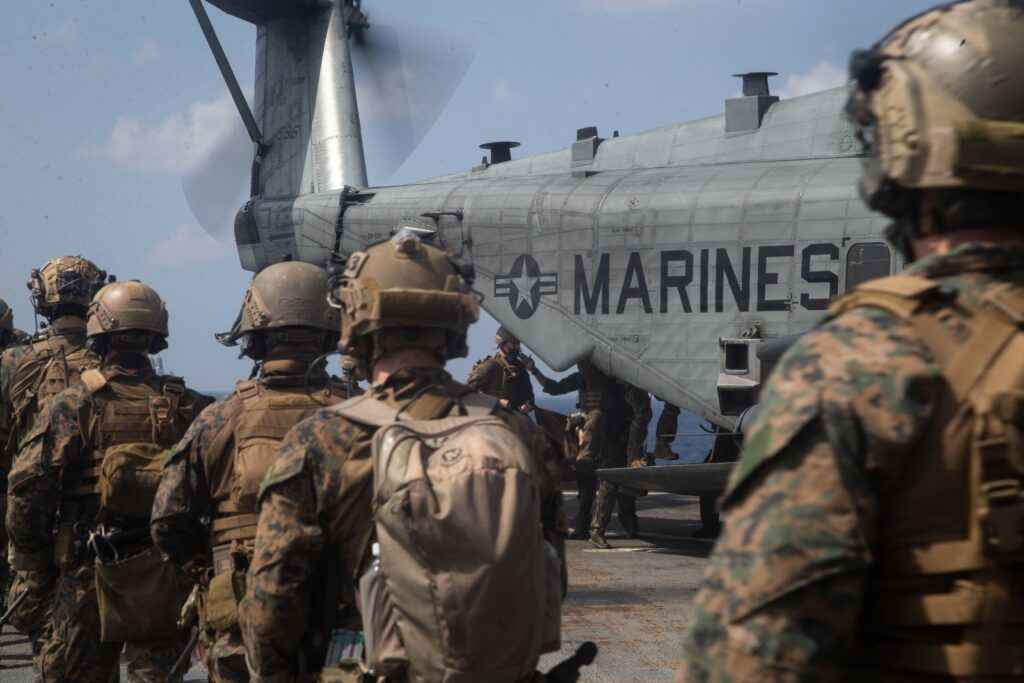Sinophobia has recently gripped much of Washington and the Pentagon in particular. While strategic planning must consider all scenarios, an overemphasis on China — while potentially giving short shrift to other threats — is not healthy for a world power.
China’s military capability is growing proportionate with its economic rise. That, combined with its increasingly authoritarian leader Xi Jinping’s hostility toward Taiwan, has convinced political leaders from both parties that a new Cold War aimed at containing Beijing’s ambitions is needed and that China remains the most likely adversary in the next conflict.
In turn, this is driving military force structure and planning increasingly toward the Indo-Pacific. The civilian and uniformed bureaucrats in the Pentagon are good at sensing where the money is flowing, and China is now the flavor of the decade.
Nowhere is this truer than in the Marine Corps, where much of its worldwide fighting capability has been traded in for equipment specialized for a Sino-American conflict. Humanitarian aid capabilities have also been sacrificed.
New ‘Great Game’ but No Existential Threat
A limited war with China over Taiwan is possible, particularly since President Joe Biden has assured Taipei that we will defend it if China attacks.
Any attempt by the Taiwanese to declare independence would almost certainly lead to belligerent actions by Beijing. However, that scenario is different from a Chinese attempt to sweep the Americans and their allies out of the Indo-Pacific area, as the Japanese undertook in 1941.
Despite that, the Marine Corps is staking its future on deterring or fighting a specific threat that may not exist.
Certainly, a new “Great Game” for influence is going on in the Indo-Pacific. The US has strengthened its ties with Japan, India, and Australia, while China has made inroads into places such as Myanmar and the Solomon Islands.
There is no existential threat to either the United States or China. The competition remains primarily diplomatic and economic. China’s Belt Road initiative is seen as exploitive in much of Southwest Asia and Africa, and the United States seems to be viewed favorably in most nations we covet as allies. None of this justifies a Cold War mentality.
If Washington desires to increase its military presence in the Indo-Pacific region, it should reinforce existing assets. Major changes to force structure based on a single threat is overhyped and unwise.
Regional Disaster Relief
China has nothing to gain from a prolonged naval war in the region and everything to lose. It is an export-driven economy, and a conflict at sea would be disastrous.
The current Marine Corps approach is based on a Chinese break-out from the First Island Chain in the East and South China Seas, like the Japanese naval blitzkrieg of 1941-42.
The Marine Corps has divested itself of tanks, tubed artillery, and heavy engineering assets that might be critical in fighting a real Chinese military threat in the region to buy anti-ship missiles.
If China is a potential adversary, nature also remains real and imminent. Volcanoes, earthquakes, massive tropical storms, and tsunamis are part of the Indo-Pacific life cycle.
For decades, the Marine Corps has been a key to regional disaster relief. Operation Sea Angel in Bangladesh in 1991 was a Marine Corps-led humanitarian/disaster relief operation that saved hundreds and thousands of lives.
Operation Unified Assistance in the wake of the devastating 2004 earthquake/tsunami that ravaged the Indo-Pacific area helped millions. A Marine commanded the operation.
Much of the vital equipment that was key to those successes is now gone from the inventory of the Corps.
Force in Readiness
In the Indo-Pacific Great Game, China is much more likely to use irregular warfare by sponsoring pro-Chinese insurgent movements against West-leaning governments in countries such as Indonesia, Malaysia, Singapore, and Vietnam rather than a direct naval assault.
In the Solomon’s, it is likely that the pro-Chinese government of Prime Minister Manasseh Sogavare will be overthrown by a popular uprising or direct ballot if one is ever held. In that case, a Chinese-sponsored insurgency to put Sogavare back in power is not only possible but likely.
The equipment the Marines have divested would be critical in such a prolonged counterguerrilla campaign.
The Marine Corps has been a worldwide resource for nearly two and a half centuries. Washington’s policymakers need to ask themselves whether it is wise to allow the nation’s force-in-readiness to concentrate on a threat that may be more myth than reality.
He lectures on Alternative Analysis at the George Washington University’s Elliott School of International Affairs.
The views and opinions expressed here are those of the author and do not necessarily reflect the editorial position of The Defense Post.
The Defense Post aims to publish a wide range of high-quality opinion and analysis from a diverse array of people – do you want to send us yours? Click here to submit an op-ed.




